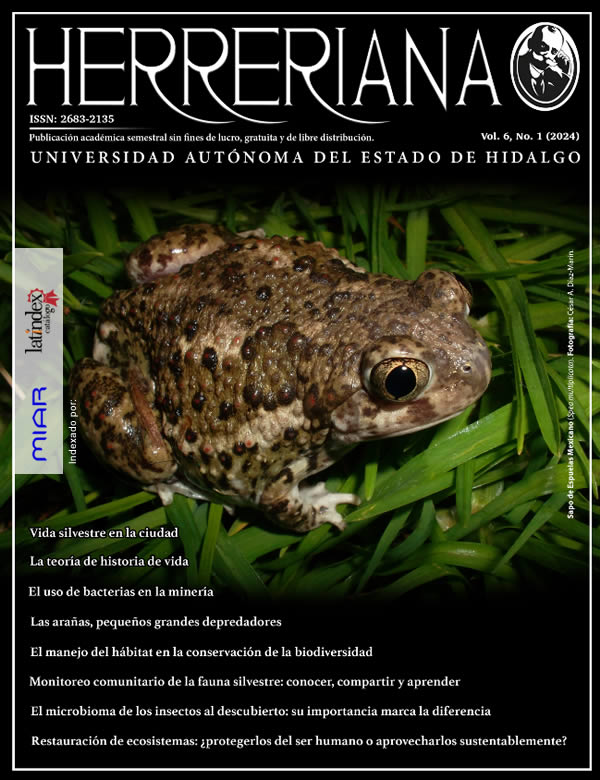Spiders, little big predators
Abstract
Spiders are well known for being generalist predators that consume any prey that is available, however, the vast majority have this tendency, others have chosen to specialize in preying on a specific type of prey, some have even chosen to feed on plants, mainly from pollen, nectar and Beltian bodies. Because of this wide variation in their diet, they have developed various strategies to capture their prey, either waiting for it to cross their path or actively hunting it.
Downloads
References
Baba, Y. G., Watari, Y., Nishi, M. y Sasaki, T. (2019). Notes on the feeding habits of the Okinawan fishing spider, Dolomedes orion (Araneae: Pisauridae), in the southwestern islands of Japan. The Journal of Arachnology, 47(1), 154-158
Calvario, A. I. C., de Luna, M., Reyes, A. M. y Calvario, X. C. (2021). Predation by the spider Tidarren sisyphoides (Walckenaer, 1841) on the ringneck coffee snake Ninia diademata Baird & Girard, 1853 in Veracruz, Mexico. Herpetology Notes, 14, 301-302.
Cheli, G., Armendano, A. y González, A. (2006). Preferencia alimentaria de arañas Misumenops pallidus (Araneae: Thomisidae) sobre potenciales insectos presa de cultivos de alfalfa. Revista de Biología Tropical, 54(2), 505-513.
Dunbar, J. P., Vitkauskaite, A., Lawton, C., Waddams, B. y Dugon, M. M. (2022). Webslinger vs. Dark Knight: First record of a false widow spider Steatoda nobilis preying on a pipistrelle bat in Britain. Ecosphere, 13(2), e3959.
Huang, D., Hormiga, G., Cai, C., Su, Y., Yin, Z., Xia, F. y Giribet, G. (2018). Origin of spiders and their spinning organs illuminated by mid-Cretaceous amber fossils. Nature Ecology & Evolution, 2(4), 623–627.
Nentwig, W. (Ed.). (2013). Spider ecophysiology. Springer Science & Business Media.
Martínez-Sánchez, I., Niño Maldonado, S., y Valencia-Herverth, J. (2013). Primer reporte para México del colibrí Archilochus colubris atrapado en una telaraña de Nephila clavipes. Huitzil, 14(2), 110-112.
Pekár, S., Coddington, J. A. y Blackledge, T. A. (2012). Evolution of stenophagy in spiders (Araneae): evidence based on the comparative analysis of spider diets. Evolution: international journal of organic evolution, 66(3), 776-806.
Pekár, S. y Toft, S. (2015). Trophic specialisation in a predatory group: the case of prey‐specialised spiders (Araneae). Biological Reviews, 90(3), 744-761.
Pérez-Miles, F. y Perafán, C. (2017). Behavior and Biology of Mygalomorphae. En: Viera C., Gonzaga M. (Eds.) Behaviour and Ecology of Spiders. Springer, Cham.
Singh, B. B., Singh, R. y Singh, G. (2020). Faunal diversity of Clubionidae, Ctenidae, Cybaeidae, Deinopidae and Desidae (Araneomorphae: Araneae: Arachnida) in India. Journal of Applied Bioscience, Lucknow, 46(1), 2.
Copyright (c) 2024 Héctor Vicente Salinas Velasco

This work is licensed under a Creative Commons Attribution-NonCommercial-NoDerivatives 4.0 International License.











